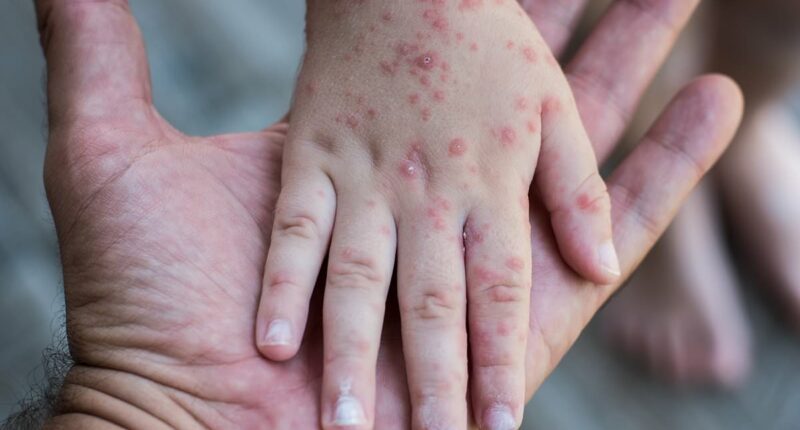Share this @internewscast.com
The United States is experiencing an unexpected surge in hand, foot, and mouth disease (HFMD), with medical professionals nationwide observing a significant increase in cases compared to previous years.
Even though HFMD is generally a mild illness affecting children and tends to peak during summer and early autumn, the current year has seen an accelerated spread and a larger number of infections than anticipated.
Notable states such as Maryland, Pennsylvania, New Jersey, Virginia, Ohio, Kansas, and West Virginia have reported a marked rise in cases. Health authorities suggest that the country might witness up to a million cases by 2025.
Specifically, in New York City, Staten Island has become a focal point of concern as healthcare providers noted a significant number of HFMD occurrences this summer, with expectations of further increases.
In Maryland, the incidence of cases has soared to four or five times the levels documented at the same period last year, as noted by Dr. Allison Agwu from Johns Hopkins University.
“This year, [cases seem] to be out of control,” Dr. Agwu remarked to HuffPost.
Pediatricians in Kansas, Wisconsin, Tennessee and Virginia have reported comparable surges to Dr Agwu
AND Some physicians say this is one of the worst spikes they have witnessed.
Traditionally, there are over 200,000 cases of HFMD in the US each year, but if the predictions are correct, the number of patients this year could be close to 1 million.

Although HFMD is typically a mild childhood illness that peaks in the summer and early fall, this year it is spreading faster than usual and affecting more people than expected
Dr Edith Bracho-Sanchez of Columbia University revealed in August that she had seen more HFMD cases this summer than in the previous decade, and Dr Natasha Burgert of Kansas said her practice was reflecting the same nationwide trend.
HFMD most commonly affects children under five, particularly those in group settings such as daycare centers, nurseries and schools.
However, doctors are also seeing infections in older children and adults, especially individuals with weakened immune systems.
Because the CDC does not track HFMD directly, exact national figures are not available.
HFMD is highly contagious and caused by viruses in the enterovirus family, most often coxsackievirus A16.
It spreads easily through respiratory droplets, saliva, stool and the fluid inside blisters. It can also spread through contaminated surfaces, toys and shared objects.
In many cases, early symptoms resemble a common cold, with fever, sore throat and a runny nose.
Within days, patients typically develop painful mouth sores, usually located at the back of the throat, along with red bumps or blisters on the hands and feet.
These rashes may peel as they heal.
Some individuals experience vomiting, and very young children can occasionally develop neurological complications, such as inflammation around the brain, which require urgent medical attention.
For most people, the illness lasts about a week, although more severe mouth ulcers can prolong recovery to ten to 14 days.
Doctors note that HFMD tends to surge in cycles, and this year’s wave is particularly intense.
Dr Matthew Thomas, a pediatric infectious diseases specialist at WVU Medicine Golisano Children’s in West Virginia, told the Economic Times: ‘Some years you’ll see a lot of cases, like we’re seeing this year, and then it kind of fades away, where you don’t hear about it for a while.’
Several factors may be contributing to the rapid spread. Seasonal mixing at camps, swimming pools, theme parks and back-to-school environments increases opportunities for transmission, and warm, humid weather can help the virus survive on surfaces and in the environment.

HFMD is caused by viruses in the enterovirus family, most often coxsackievirus A16
Meanwhile in the fall, once children return to classrooms, daycares, and nurseries, the virus has a tendency to continue its spread.
Water parks have drawn attention as potential hotspots; in July, a Philadelphia water park temporarily closed after a child who had visited later tested positive for HFMD.
If water is not properly treated, virus particles can be swallowed and cause infection.
There is no vaccine and no antiviral medication for HFMD. Treatment focuses on easing symptoms with over-the-counter pain relievers and ensuring adequate hydration, particularly for children who find swallowing painful due to mouth sores.
Medical care is recommended if a child or adult cannot stay hydrated, has prolonged fever, struggles to eat, or shows signs of serious complications such as extreme fatigue or breathing difficulties, though these cases are rare.
Doctors emphasize that prevention relies on consistent hygiene practices.
Frequent hand-washing with soap and water, using alcohol-based hand sanitizers when washing is not possible, avoiding touching the face, cleaning shared surfaces, and staying away from sick individuals all reduce the risk of infection.
Children diagnosed with HFMD should remain home for at least seven days to avoid spreading the virus to others. With cases rising across the country, health experts are urging families and caregivers to remain vigilant and take precautions to limit transmission.






